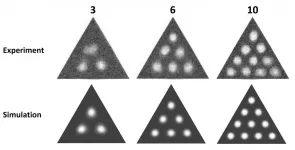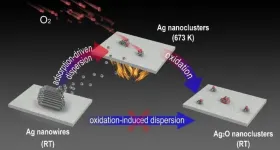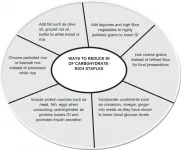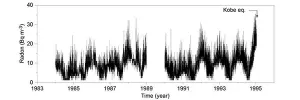Protein discovery could help enable eco-friendly fungicides
Findings explain how plants use RNA to defend against fungal invaders
2021-03-04
(Press-News.org) New research reveals an essential step in scientists' quest to create targeted, more eco-friendly fungicides that protect food crops.
Scientists have known for decades that biological cells manufacture tiny, round structures called extracellular vesicles. However, their pivotal roles in communication between invading microorganisms and their hosts were recognized only recently.
UC Riverside geneticist Hailing Jin and her team found plants use these vesicles to launch RNA molecules at fungal invaders, suppressing the genes that make the fungi dangerous.
"These vesicles shuttle small RNAs between cells, like tiny Trojan horses with weapons hidden inside," said Jin, a professor of genetics and the Cy Mouradick Chair in the Department of Plant Pathology and Microbiology. "They can silence pathogenic fungal gene expression."
Using extracellular vesicles and small RNAs has several advantages over conventional fungicides. They're more eco-friendly because they are similar to naturally occurring products. Eventually, they degrade and do not leave toxic residues in the soil. Also, Jin explained, this method of fighting fungi is less likely to breed drug-resistant pathogens.
A sticking point for scientists in creating these fungicides has been figuring out how to load their desired small RNAs into the vesicles.
"We've wondered how these weaponized small RNAs get into the bubbles," Jin said. "Now, we think we have an answer."
Her laboratory has identified several proteins that serve as binding agents, helping to select and load small RNAs into the vesicles. The lab's research is detailed in a new Nature Plants journal article.
The Jin laboratory has been working for several years on the development of gene-silencing RNA fungicides. Work toward this goal led to the team's landmark discovery in 2013 that gene-silencing RNA messages can be sent from the fungal pathogen to the plant host to suppress host immunity. Later, the team learned small RNAs can move both ways -- from plants into pathogenic invader cells as well.
In 2018, the team worked out that extracellular vesicles were the major delivery system for these small RNAs. They observed that Arabidopsis plants secrete extracellular vesicles into Botrytis cinerea, a fungus that causes grey mold disease and destroys millions of crops every year.
"This was the first example of a host using these vesicles to deliver small RNAs to another organism," Jin said. "Previously we saw movement of RNA, but didn't know how the small RNA are selected and transported."
Now, she and her colleagues have identified several RNA-binding proteins in Arabidopsis that bind to specific small RNA molecules and load them into extracellular vesicles. This suggests the proteins play an important role in loading and stabilizing small RNAs in the vesicles. The finding can help increase the payload of gene-silencing RNAs that make it into vesicles and enhance the efficiency of disease control.
Some scientists have taken inspiration from the RNA communication in plant vesicles to design human therapies. For example, some are attempting to load anti-cancer RNAs and drugs into extracellular vesicles in fruits or vegetables, so people can eat or drink them. Jin is hopeful that her lab's discovery can aid these efforts.
INFORMATION:
[Attachments] See images for this press release:

ELSE PRESS RELEASES FROM THIS DATE:
2021-03-04
In a close collaboration between experimental and theoretical physicists at Johannes Gutenberg University Mainz (JGU), the research groups of Professor Mathias Kläui and Dr. Peter Virnau investigated the behavior of magnetic whirls within nanoscale geometric structures. In their work published in Advanced Functional Materials, the researchers confined small magnetic whirls, so-called skyrmions, in geometric structures. Skyrmions can be created in thin metal films and have particle-like properties: They exhibit high stability and are repelled from each other and from specially prepared walls. Experiments and accompanying computer simulations showed that the mobility of skyrmions within these geometric structures depends massively on their arrangement. In triangles, ...
2021-03-04
Oxidative dispersion has been widely used in the regeneration of sintered metal catalysts as well as the fabrication of single-atom catalysts.
The consensus on the oxidative dispersion process includes the formation of mobile metal oxide species from large metal particles and the capture of these species on a support surface. Nevertheless, the mechanism of oxidation-induced dispersion has yet to be confirmed via in situ electron microscopic and/or spectroscopic characterizations.
Recently, a research team led by Prof. FU Qiang and Prof. BAO Xinhe from the Dalian Institute of Chemical Physics (DICP) of the Chinese Academy of Sciences (CAS), in collaboration with Prof. YANG Bing from DICP and Prof. GAO Yi ...
2021-03-04
Administering zinc supplements to covid-19 patients with low levels of this element may be a strategy to reduce mortality and recovery time. At the same time, it could help to prevent risk groups, like the elderly, from suffering the worst effects of the disease. These are the findings of a study by physicians and researchers from the Hospital del Mar, Hospital del Mar Medical Research Institute (IMIM) and Pompeu Fabra University (UPF), led by Dr. Robert Güerri, a physician at the Infectious Diseases Service of Hospital del Mar, which has just been published in the journal Nutrients.
The study analysed the zinc levels of 249 adult patients treated at the centre between 9 March and 1 April 2020, with an average age of 65 years. The most common symptoms presented at the time of ...
2021-03-04
Researchers discover how to control zinc content in plants: Could help the world's malnourished
Over 2 billion people worldwide are malnourished due to zinc deficiency. Led by the University of Copenhagen, an international team of researchers has discovered how plants sense zinc and use this knowledge to enhance plant zinc uptake, leading to an increase in seed zinc content by 50 percent. The new knowledge might one day be applied towards the cultivation of more nutritious crops.
A deficiency of zinc and other essential dietary nutrients is one of the greatest causes of malnutrition worldwide. More than two billion people are estimated to suffer from zinc deficiency, a problem that can lead to impaired immune systems, mental disorders and stunting. Among other things, ...
2021-03-04
Glycine can stimulate or inhibit neurons in the brain, thereby controlling complex functions. Unraveling the three-dimensional structure of the glycine transporter, researchers have now come a big step closer to understanding the regulation of glycine in the brain. These results, which have been published in Nature, open up opportunities to find effective drugs that inhibit GlyT1 function, with major implications for the treatment of schizophrenia and other mental disorders.
Glycine is the smallest amino acid and a building block of proteins, and also a critical neurotransmitter that can both stimulate or inhibit ...
2021-03-04
The oceans are becoming more acidic because of the rapid release of carbon dioxide (CO2) caused by anthropogenic (human) activities, such as burning of fossil fuels. So far, the oceans have taken up around 30% of all anthropogenic CO2 released to the atmosphere. The continuous increase of CO2 has a substantial effect on ocean chemistry because CO2 reacts with water and carbonate molecules. This process, called 'ocean acidification', lowers pH, and calcium carbonate becomes less available. This is a problem for calcifying organisms, such as corals and molluscs, that use calcium carbonate as the main building blocks of their exoskeleton.
In particular, organisms that build their shells from a type of calcium carbonate known as 'aragonite' are in trouble because aragonite is ...
2021-03-04
?Micro-Doppler radars could soon be used in clinical settings to predict injury risk and track recovery progress, according to Penn State researchers.?
Being able to view subtle differences in human movement?would allow health care workers to more accurately identify individuals who may be at risk for injury and to track progress precisely while individuals are recovering from an injury. In an effort to find an accurate, reliable and cost-effective way to measure these subtleties ?in human movement, College of Engineering and College of Medicine researchers teamed up to develop a radar in front ...
2021-03-04
Professor Christiani Jeyakumar Henry, Senior Advisor of Singapore Institute of Food and Biotechnology Innovation (SIFBI), Agency for Science, Technology and Research (A*STAR) and his team have developed a Glycaemic Index (GI) glossary of non-Western foods. The research paper was published in Nutrition & Diabetes on 6 Jan 2021: https://doi.org/10.1038/s41387-020-00145-w.
Observational studies have shown that the consumption of low glycaemic index (GI) foods is associated with a lower risk of type 2 diabetes mellitus (T2DM), significantly less insulin resistance and a lower prevalence of the metabolic syndrome. However, most published GI values focus on Western foods with minimal inclusion of other foods from non-Western countries, hence their application ...
2021-03-04
Tohoku University researchers have unearthed further details about radon concentration in the atmosphere before and after earthquakes, moving us closer to being able to anticipate when large earthquakes may hit.
The results of their research were published in the journal Science Reports on February 18, 2021.
Radon is a radioactive noble gas derived from radioactive decays of radium-226 in the ground. Radon bubbles up to the surface and is expelled into the atmosphere.
It has long been known that elevated levels of radon underneath the ground can be detected before and after earthquakes. But the relationship between the mechanisms that cause abnormal changes in radon concentration and the occurrence of earthquakes requires greater ...
2021-03-04
Interspecies interactions are the foundation of ecosystems, from soil to ocean to human gut. Among the many different types of interactions, syntrophy is a particularly important and mutually beneficial interspecies interaction where one partner provides a chemical or nutrient that is consumed by the other in exchange for a reward.
Syntrophy plays an essential role in global carbon cycles by mediating the conversion of organic matter to methane, which is about 30 times more potent than carbon dioxide as a greenhouse gas and is a source of sustainable energy. And in the human gut, trillions of microbial cells also interact ...
LAST 30 PRESS RELEASES:
[Press-News.org] Protein discovery could help enable eco-friendly fungicides
Findings explain how plants use RNA to defend against fungal invaders






